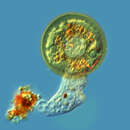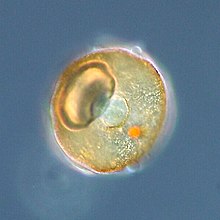en
names in breadcrumbs


Arcella is a genus of testate amoebae in the order Arcellinida, usually found in freshwaters and mosses, and rarely in soils. A key characteristic of Arcella is the circular test with a hole on its center from where finger-like pseudopods emerge. It is one of the largest testacean genera.
An Arcella is typically enclosed in a chitinous, umbrella-shaped test (or shell) that has a single central aperture through which the pseudopods – which are used for locomotion – extend out.[1] In some species the aperture is surrounded by a ring of pores. The test is composed of organic material with a diameter of up to 300 µm and is transparent or light-yellow-colored in young Arcella, but browns while aging due to the progressive deposition of iron and manganese compounds.[2] Contrary to other genera, no gravel chips or other foreign bodies are inserted to strengthen the housing.
Different species of Arcella can have different number of nuclei, ranging from a single nucleus, as in some A. hemisphaerica, up to 200 nuclei, as in A. megastoma, though the majority is binucleate.[2] They also have many contractile vacuoles, and can develop vacuoles of carbon dioxide in their cytoplasm to float up to the surface of the water.
Arcella inhabit freshwater pools, eutrophic waters, marshes, mosses, as well as wet foliage. Few species can also be found in soils. They nourish on diatoms, unicellular green algae or animal protozoa such as flagellates and ciliates.
Most species are worldwide-distributed, but some have restricted distributions, e.g. A. brasiliensis and A. rota which are endemic to South America.
They eat by stretching out their pseudopods to surround the food and bring it back to the microorganism.
Over 130 species and subspecies of the genus Arcella have been described so far. Species include:
 Arcella species
Arcella species Arcella is a genus of testate amoebae in the order Arcellinida, usually found in freshwaters and mosses, and rarely in soils. A key characteristic of Arcella is the circular test with a hole on its center from where finger-like pseudopods emerge. It is one of the largest testacean genera.